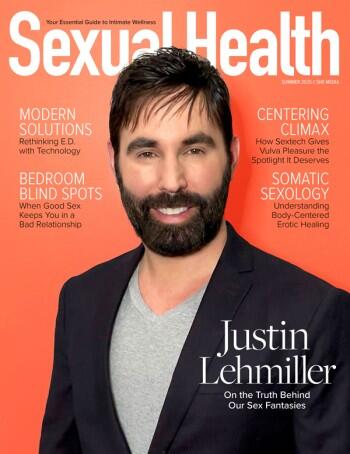In marketing, there tends to be an emphasis on the younger generation — the trendsetters. The assumption is that appealing to the younger market has a halo effect on older consumers, who look to younger folks for what is on trend. There is certainly value in understanding what young people perceive as having a massive aura, but broadening access to pleasure is our industry’s bread and butter. That’s why it is important to recognize, understand and cater to the growing number of folks in midlife who are highly focused on maintaining their physical wellness and their sex lives.
Demographics + Awareness = Opportunity
These are folks who are experiencing the effects of the hormonal changes that come in midlife but are not willing to sacrifice their sexual pleasure, their health or their wellness as they get older. They are actively seeking solutions to the side effects of aging that limit them — and our industry has solutions to offer.
Millennials have all entered their 30s, and some elder millennials — including yours truly — are approaching their mid-40s. Gen X is now 45-60. These two groups make up 50% of the population in North America and outnumber Gen Z by 54%.
At the same time, awareness of midlife changes is exploding, as conversations about the intersections of physical and sexual wellness are taking place in the public eye on a scale we have never experienced before. From Oprah’s recent special “The Menopause Revolution” and Dax Shepard’s interview with menopause expert Dr. Mary Claire Haver, to Andrew Huberman’s lesson on optimizing testosterone and estrogen, to Mel Robbins’ dive into erectile dysfunction with Dr. Rena Malik, sex and aging are now front and center. The algorithms that tailor our social media feeds, podcast recommendations and mainstream entertainment target folks in midlife with information and entertainment about the latest aging hacks.
The upshot: A huge number of these midlife consumers are body-conscious, pleasure-accepting and aging-informed. These are folks who are experiencing the effects of the hormonal changes that come in midlife but are not willing to sacrifice their sexual pleasure, their health or their wellness as they get older. They are actively seeking solutions to the side effects of aging that limit them — and our industry has solutions to offer.
Knowledge Is Power
If you are in the dark about the physical, mental and emotional changes associated with midlife, now is a great time to get up to speed. Educate yourself and your staff on sexual wellness in mid- and later life.
Both men and women experience gradually decreasing testosterone levels, the effects of which include decreased libido, slower sexual response, declining blood flow, erectile irregularity and reduced responsiveness to pleasurable stimuli. The fluctuations in estrogen and progesterone that accompany perimenopause, and eventually menopause, can start as early as 35 and can cause vaginal pain and dryness, increased risk of UTIs, declines in muscular control throughout the body — including the vagina — and slowed arousal patterns or reaching orgasm.
All these factors impact individuals’ and couples’ sexual expression and capabilities. The good news is that this information, and discussions about ways to counteract these unwanted sexual health symptoms, are now out in the open. You don’t want to lag behind your customers when it comes to awareness and knowledge of midlife sexual wellness issues.
Pleasure Products for Midlife Shoppers
Chances are you already stock products that meet the needs of midlife consumers. A few popular categories are especially relevant and impactful for the midlife shopper. Powerful vibrators that can be used on many areas of the body, like wands, help users to build full-body arousal slowly, which is a must when blood flow slows and responsiveness to touch changes. Kinky sensation play gear can also create full-body pleasure, and help couples curious about exploring beyond PIV (penis-in-vagina) sex. Of course, body-safe lubricants help combat vaginal dryness and allow for longer sessions of play. Prostate toys and cock rings create opportunities to build arousal and pleasure without the prerequisite of hardness. Understanding midlife customers will help you take full advantage of your selection and match products to their needs and desires.
Getting the Message Out
When you achieve a clearer focus on what offerings are most appropriate and appealing for folks in midlife, you can also share your message with them more effectively. If your marketing strategy is targeted toward Gen Z platforms, chances are you are missing out on the midlife movement. While I am not recommending throwing out any channels where you have seen results, I do recommend attuning your strategies on those channels to include midlife consumers. If you have a fruitful influencer program, engage midlife experts who are influencers in their own right. If events are where you connect best with your audience, seek out any of the growing number of menopause, biohacking or mental health conferences out there. Facebook continues to be a space where private groups convene to share resources and tips. Practitioners working with midlife clients, who have built and moderate many of these digital community spaces, are ideal people to partner with.
Traditionally, midlife has been treated as the point in life when sexual desires wane, bodies become fodder for light humor — we’ve all seen the dad bod memes — and women, in particular, become invisible. The midlife movement is changing this paradigm by promoting a life cycle approach where vitality, pleasure, strength and mental clarity remain within reach. The pleasure industry has valuable resources, knowledge and tools to contribute to this growing movement, and to take advantage of an important and lucrative opportunity.
Sarah Tomchesson (she/her) has spent much of her career as a brand strategist shaping legendary pleasure brands, including her current role as the marketing director for Magic Wand. She is a certified sexuality educator and intimacy coach and co-hosts a weekly podcast, “F*ck Yeah.” Tomchesson also serves as vice chair of the board of directors of SIECUS — Sex Ed for Social Change, the nation’s leading organization advocating for sex education policy reform.








